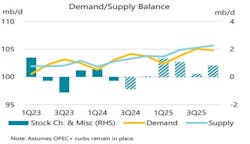IEA: Oil markets exhibit high volatility over recent weeks
Oil markets exhibited high volatility in recent weeks on unexpected economic data, the International Energy Agency (IEA) said in the August issue Oil Market Monthly Report.
“Benchmark crude oil prices tumbled sharply lower in July and early August as unexpected economic data threw the market off balance. Questions over the health of the global economy re-emerged as Japan increased interest rates sparking a reversal in yen carry trades, China’s outlook deteriorated and US hiring slowed in July. But persistent geopolitical tensions in the Middle East and some relatively positive macroeconomic data backstopped weakness in oil futures, with prices rebounding higher in the second week of August. Moreover, OPEC+ cuts are also tightening physical markets, lifting North Sea Dated to a $2/bbl premium against the front-month ICE contract,” IEA said.
Overall, global oil demand increased by 870,000 b/d in second-quarter 2024, with a contraction in China limiting gains, according to IEA estimates.
Chinese oil demand fell by an estimated 110,000 b/d year-over-year (y-o-y) in second-quarter 2024 with all 3 months showing declines. This was 560,000 b/d below IEA’s expectation at the start of the year.
“Chinese oil demand growth has gone into reverse due to a slowdown in construction and manufacturing, rapidly accelerating deployment of vehicles powered by alternative fuels and comparison to a stronger post-reopening baseline,” IEA said.
IEA anticipates some improvement during this year’s second half for an overall annual increase of 300,000 b/d, with China remaining the largest source for global demand growth for the year as a whole. In 2025, gains are projected at 330,000 b/d, taking average consumption to 17.1 million b/d, but with the risk skewed to the downside.
Overall, global oil demand is set to rise by less than 1 million b/d in both 2024 and 2025, largely unchanged from last month’s report and far slower than last year’ s 2.1 million b/d growth as comparatively lackluster macroeconomic drivers come to the fore.
World supply rose 230,000 b/d to 103.4 million b/d in July as a substantial OPEC+ increase more than offset losses from non-OPEC+. Annual gains are expected to accelerate to 1.9 million b/d in 2025 from 730,000 b/d in 2024. Non-OPEC+ production increases by 1.5 million b/d this year and next, while OPEC+ may fall by 760,000 b/d in 2024 but rise by 400,000 b/d in 2025 if voluntary cuts stay in place.
“Despite the marked slowdown in Chinese oil demand growth, OPEC+ has yet to call time on its plan to gradually unwind voluntary production cuts starting in the fourth quarter. Its Joint Ministerial Monitoring Committee (JMMC) reiterated on 1 August, however, that the group could pause or reverse its decision depending on prevailing market conditions. Our current balances suggest that even if those cuts remain in place, global inventories could build by an average 860,000 b/d next year as non-OPEC+ supply increases of around 1.5 million b/d in 2024 and again in 2025 more than cover expected demand growth,” IEA commented.
Global refinery throughputs are forecast to increase by 840,000 b/d to 83.3 million b/d in 2024, and by 600,000 b/d to 83.9 million b/d next year. Margin weakness continues to weigh on processing rates, with Chinese runs now expected to decline y-o-y. Margins fell further in July in Europe but rose in Singapore and on the US Gulf Coast, led by stronger naphtha and gasoline cracks.
Global observed oil inventories fell by 26.2 million bbl in June, following 4 months of builds totaling 157.5 million bbl. OECD onshore stocks declined by 19.5 million bbl but were mostly offset by a 17.5 million bbl increase in non-OECD countries. Oil on water declined for a third consecutive month, by 24.2 million bbl. OECD Industry inventories were down by 21 million bbl, largely in line with the seasonal norm.
